The appearance of life itself in the mouth and eyes [of the young girl] lures one into believing that everything seen in the picture corresponds with what the painter saw. The matter is complicated by what the artist knew, which was the Dutch tradition of painting tronies that had flourished for about forty years. The now-defunct term tronie (compare the French trogne) refers to heads, faces, or expressions, and is commonly employed to describe a type of picture known especially from examples by Rembrandt and his followers (fig. 1, 2, 3 & 4). The majority of Dutch Ironies appear to have been based on live models but the works were sold as studies of interesting characters (an old man, a young woman, a 'Turk', and so on). Painters such as Jacob Backer, Govert Flinck, and Samuel van Hoogstraten painted bust-length ironies that display their talent for recording (or inventing) facial types, capturing expressions, conveying textures and light effects, arranging poses (which are far more diverse than in portraiture), and imagining personalities. Vermeer owned two ironies each by Van Hoogstraten and Carel Fabritius, and he painted more of them than are known today.
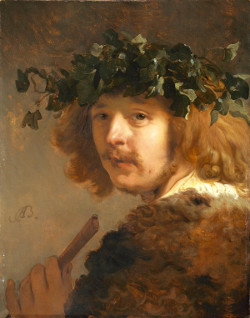
Jacob Adriaensz Backer
c. a 1640
Oil on canvas
52.2 x 40.8 cm.
Mauritshuis, The Hague
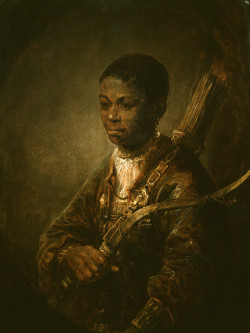
Govaert Flinck
c. 1639–1640
Oil on canvas, 66.2 x 50.8 cm.
The Wallace Collection, London
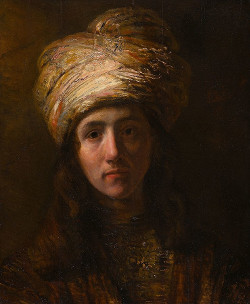
Follower of Rembrandt Harmenszoon van Rijn
c. 1650
Oil on panel, 57.3 x 47.4 cm.
Art Institue of Chicago, Chicago
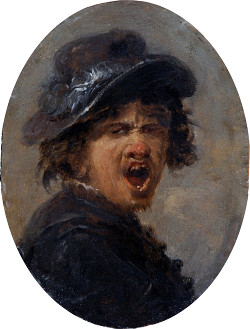
Joos van Craesbeeck
c. 1635
Oil on panel, 33 x 24.8 cm
Collection of Alfred and Isabel Bader, Milwaukee
The ironies in The Hague and New York are less reminiscent of examples by Rembrandt disciples than by artists from Leiden and Utrecht: for example, Frans van Mieris's picture of a woman in a fanciful beret (Van Mieris's equally small portrait of his wife is usually cited) and Jan van Bronchorst's Young Woman in Profile (fig. 5). The similarity with Van Mieris may have been more obvious in the past, for the background of Girl with a Pearl Earring was evidently a glossy and very dark green, against which the head resembled 'a perfect illusion of a precious object made of enamel'. Even if this description overstates the case, Van Mieris's stylistic differences never hindered admiration of his work by Vermeer and other Delft painters.
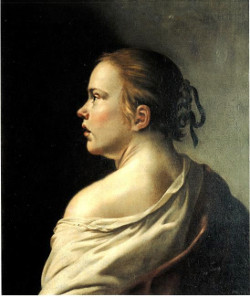
Jan van Bronchorst
1640–1645?
Oil on canvas, 56,5 x 49 cm.
Lowe Art Museum, Coral Gables (Florida)
However, the most intriguing connection is with Michiel Sweerts 1618–1664), the Brussels painter who about 1660–1661 worked in Amsterdam (A Young Maidservant (fig. 6), probably dates from that period). Paintings by Sweerts may have been brought to Vermeer's attention by Louis Cousin (Luigi Gentile, 1606–1667), who was Sweerts's colleague in Brussels during the late l650s and earlier in Rome. It was in the company of Cousin and Father Leo Maes of Brussels (both of whom were connected with the court at The Hague) that the French diplomat and diarist, Balthasar de Monconys, paid his well-known visit to Vermeer in Delft, on 11 August 1663 ). Sweerts must have painted a few dozen tronies between 1656 (when small prints after his drawings of 'Diversae Facies' were published in Brussels) and his departure from the Netherlands in late 1661. His bust-length figures are usually set against dark backgrounds and are remarkable for their simplicity, immediacy, sidelong glances, and sensitive handling of light. Sweerts occasionally painted figures in 'oriental' costumes but for the most part his models seem more from the everyday world than the 'girl with the pearl earring' (and an impromptu turban) appears to be.
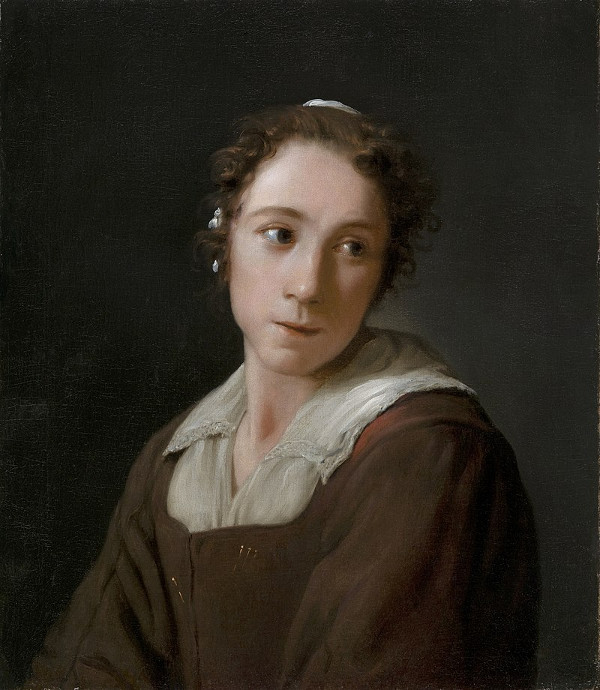
Michael Sweerts
1661
Oil on canvas, 61 x 53.5 cm.
Kremer Collection
The picture is not only one of the most beautiful in Holland, but the most satisfying and exquisite product of brush and color that I have ever seen, and, though Dutch, how unlike any other Dutch work!
Think of what has been happening in the world during the years this sweet face was set upon canvas (fig. 7)—the evolutions and tragedies, the lives lived and ended, the whole passionate, fretted progress of the nations. Leonardo's Mona Lisa (fig. 8) has been looked upon every day for centuries except in that dark period when she was stolen; but this child, much more wonderful as a conquest of man over pigment, wasted her fragrance, for she was bought at the Hague auction a few years ago for two florins, thirty cents, her surface was obliterated.
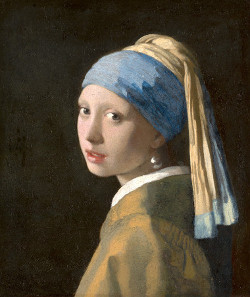
Johannes Vermeer

Leonardo da Vinci
c. 1503–1504
Olio su tavola di pioppo, 77 x 53 cm.
Museo del Louvre, Parigi
But leaving aside the human interest in this picture, did you ever see such ease as there is in this painting, such concealment of effort? It is though the paint evoked life rather than counterfeited it: as though the child has been waiting there behind the canvas to emerge at the touch of the brush wand.
"Vermeer the Magical" as I have called him, and there is magic here. You are in the presence of the unaccountable. Paint—a recognized medium—has exceeded its power. The line of the right cheek is surely the sweetest line ever suggested.
The blue-yellow head covering of the portrait in The Hague and the yellow cape (?) round the shoulders are not usual wear for those times. It is a special dress, which suits children and which children delight in, just because it is unusual and different and attractive in colour. Just with such a fancy-dress children betray that they are still childish. There is an indisputably something naive, but something honest and genuine too in this finery, also something harmonious, a simple personality still living unconsciously, which grasps at the things which match is being, without caring for anything else. Even though the garb is unusual, if we measure it against what was then worn, it is certainly not so when understood from a point of view of a child's mind. Then the clothes take on a significance which must not be underestimated, because the shape and content merge in harmony. The small portrait at The Hague is of a simplicity and naiveté which only the greatest masters are able to reproduce.
Vermeer is well protected; little of his life or personality pierces his armor. And when some disturbing experience does penetrate within the shell he proceeds to enclose it in a pearly covering of style until its sharpness is assimilated.
In the radiograph of the Head of the Girl (fig. 9) it will be immediately clear that the solid painting on which the picture was based is arranged rather differently from the surface we see. The first stage of the painting evidently consisted of a sharply contrasted pattern of light and dark: it might have been accomplished by applying a mixture of white lead solidly to the canvas. There is nothing tentative about it. There has been no correction, nor is there evidence of line or design. The difference is rather in the fact that it presents us, when we rediscover it, with the raw material of that authenticity which compels our eye in the finished work. Nothing is recorded but the oblique fall of light on particular forms. And from it there emerges an impression of a specific person, of the depth of her eye for instance and her abject, patient mouth, more positively even than from the picture that we know. No artist's method reveals this immediate and perfect objectivity: the radiography of the painting has indeed never shown a form in itself as wonderful as this strange, impersonal shape.

Johnnes Vermeer
"...the Girl in a Turban (Girl with a Pearl Earring) in The Hague, could take its place beside a Bellini Madonna, the Petrus Christus portrait of a young woman in Berlin (fig. 10), and perhaps even Piero della Francesca. It will be remembered that, confronting the Madonna di Sinigallia in Urbino (fig. 11) Roberto Longhi invoked the spirit of the master of Delft. And it comes to no surprise that in recent years an affinity has been repeatedly observed between the visual approach of Vermeer and that of Jan van Eyck: the lens-like vision, the luminous "positive" colour, the calm devoted attitude before still, silent objects—these are qualities common to both artists."
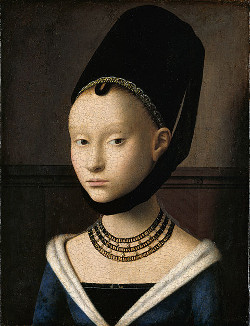
Petrus Christus
c. 1465–70
Oil on canvas, 29 x 22.5 cm.
Gemäldegalerie, Berlin
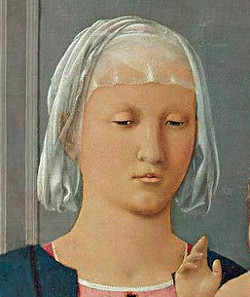
Piero della Francesca
c. 1474
Oil on panel, 67 x 53.5 cm.
Galleria Nazionale delle Marche, Urbino
About 1660 pearl ear-drops were very much the fashion in Holland; we find them in the female portraits and genre-pieces of Terborch Metsu, Mieris and many other artists. But with Vermeer these large, drop-shaped, gleaming pearls become the points of convergence of light, symbols of the beauty of the worlds. (It would seem that later generations did not approve Vermeer's pearls, for in one case a large pearl of this kind was overpainted and replaced by an ornamental gold ear-drop.) In the portrait of the girl in The Hague, the pearl gleams just like her eyes—eyes and pearls have absorbed the earthly light and glow with light and beauty. If pearls can be the embodiment of earthly, transient beauty, how are we to interpret the picture of the Last Judgment behind the Lady Weighing Pearls? Vermeer's symbolism is not hard to understand.
The four surviving heads, all of women, painted by Vermeer have suffered both over-admiration and critical neglect. They are not as closely related as reproductions might suggest, but the soft texture of the Frick Lady with Her Maid certainly is not to be found in the Hague Girl with a Pearl Earring (fig. 12). This famous picture has often been compared with the Portrait of a Young Woman (fig. 13) which is now in a private collection in New York. In terms of the handling of the paint the two pictures differ. Neither is in perfect condition, although the Hague picture, perhaps, has been over-praised, while the privately owned one has been thought to be in a worse state than, in fact, it is. The latter is less glamorous than its more famous counterpart, and yet, so much of what is admired in Vermeer is there. She exists in a world of her own, with the self-contained quality which gives Thoré-Burger's extravagant comparison with the Mona Lisa some justification.. Her gentle smile is an external enigma; she is the sphinx without a secret.

Johannes Vermeer

Johannes Vermeer
The Girl with a Pearl Earring, is much more direct, less mysterious, but the picture has suffered much. There is the same impenetrable background exactly as in the Frick Lady with her maid, and so we must be content with a shadow of what must have been in the partly open lips and the almost come-hither gaze.
The Girl with a Pearl Ear-ring in the Mauritshuis is even more difficult to place in sequence than The Concert in the Gardner Museum. Vermeer concentrates on the glance the girl casts over her left shoulder as her eyes meet ours. her shining eyes, her moist lips, and the modeling of her face and dress succeed in convincing us of their perfect naturalness. But even if we compare the painting with a work by Frans van Mieris from about 1658 (fig. 14), a work which may even have provided Vermeer's source of inspiration, Vermeer's tendency to idealize is very apparent.
Van Mieris dresses his model in clothes of the current fashion, and conscientiously differentiates the nearly palpable textures of velvet, fur and cotton. Vermeer, by the contrast, avoids specifics: his girl wears an apparently fanciful costume of a single, indeterminate fabric. While Van Mieris delicately models the plasticity of the face, indicating all its imperfections and idiosyncrasies, creating the effect of a portrait, Vermeer only indicates the rhythmic beautiful contour of the face and keeps detail to a minimum. (The line of the nose is, in fact, invisible; the bridge of the nose and the right cheek simply flow into each other, forming a single area of absolutely even colour.) In no other painting by Vermeer do we see so clearly how his truthfulness to nature was coupled worth a desire to represent it in its ideal state.
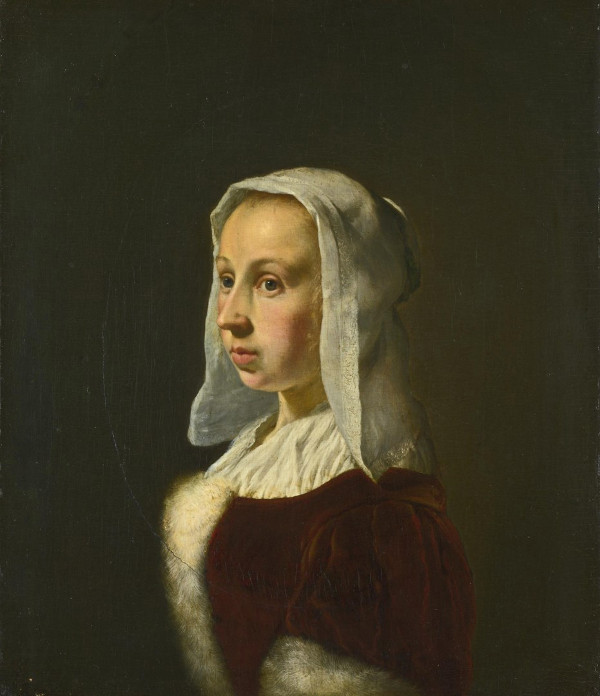
Frans van Mieris
c. 1657–1658
Oil on vellum, inlaid on oak at a later date, 16 x 13.3 cm.
Nationl Gallery, London
It is always the beauty of this portrait head—its purity, freshness, radiance, sensuality—that is singled out for comment. Vermeer himself, as Gowing notes, provides the metaphor: she is like a pearl. Yet there is sense in which this response, no matter how inevitable, begs the question of the painting, and invades the claims it makes upon the viewer. For to look at it is to be implicated in a relationship so urgent that to take an instinctive step backward into aesthetic appreciation would seem in this case a defensive measure, an act of betrayal and bad faith. It is me at whom she gazes, with real, unguarded human emotions, and with an erotic intensity that demands something just as real and human in return. The relationship may only be with an image, yet it involves all that art is supposed to keep at bay.
And although it is a moment of human interiority at the heart of the painting that gives it such resonance, it is still the private, ultimately inaccessible nature of the experience that Vermeer contemplates, enclosing it in a world positited over there, out of reach. As a result, the world he opens is impregnated with imaginative life, and seems miraculously close at hand.
As this girl stares out at the viewer with liquid eyes and parted mouth, she radiates purity, captivating all the gaze upon her. Her soft, smooth skin is as unblemished as the surface of her large tear-drop shaped earring—like a vision emanating from the darkness, she belongs to not specific time or place. Her exotic turban, wrapping her head in crystalline blue, is surmounted by a striking yellow fabric that falls behind her shoulders, lending an air of mystery to the image.
The key to the painting lies in the turn of the woman's head. Nowhere else in Vermeer's oeuvre is a painting so forcefully organized around a single axis. The woman's head rotates around a vertical line, a shadow, that runs from her left temple to her left shoulder and torso. She turns her head against the direction of her body, toward the viewer; her eyes complete a ninety-degree pivot that the head by itself cannot, or will not sustain. In doing so, the girl with the earring repeats the tension between body posture (parallel to the picture plane) and regard to-the-viewer (perpendicular to the picture plane) that had earlier defined the central figure in The Girl with a Wineglass. This angling of the head, a direct address to the viewer that cuts against the lateral position of the body, defines almost without exception every woman who looks out at the viewer in Vermeer's oeuvre subsequent to The Girl with a Wineglass.
The Girl with a Pearl Earring encompasses Vermeer's deepest feelings about perception, reduced with extraordinary brilliance to the sparest of iconographies: the rotated head of a costumed woman. Her turn to the viewer interrupts whatever bodily narrative she might otherwise tell.
LITERATURE
(from the catalogue of the Washington/The Hague Vermeer exhibition, Arthur K. Wheelock Jr., Johannes Vermeer, (with contributions by Albert Blankert, Ben Broos, and Jørgen Wadum), 1995.
| Author | Date | Page(s), Catalogue Number, Illustrations and Plates |
| Bredius | 1885 | 222 |
| Lafenestre | 1898 | 106 |
| Geoffroy | 1900 | 118–- 119 and ill. |
| Martin | 1904 | 4 |
| Hofsteded de Groot | 1907–- 1928 | 1: 606, no. 44 |
| Veth | 1908 | 10 |
| Lpietzsch | 1911 | 117, no. 21 and pl. 16 |
| Hale | 1937 | 173–174, and pl. 4 |
| De Vries | 1939 | 42, 84, no. 17 |
| Swillens | 1950 | 62, no.28, 105– 108, and pl. 28 |
| Gowing | 1952 | 137–139, no. 22, ill. 39 and pl. 49 |
| Block | 1962 | 23, no. 49 and ill. 3 |
| Goldschieder | 1967 | 27, 130, no. 23 and pls. 54-55 |
| Blankert | 1975 | 66-68, 88, 152, no. 18, and ill. |
| Van Straaten. | 1977 | 73, no. 92a and ill |
| Blankert | 1978 | 46, 59, 163, no. 18 and pls. 18–18a |
| Slatkes | 1981 | 68-69, and ill. |
| Wheelock | 1981 | 118, 132, and pls. 28 |
| Brentjens | 1985 | 55-56, and ill. 3 |
| Ailaud | 1986 | 122, 142, 146, 185, no. 18 and pl. 18 |
| Wheelock | 1988 | 92-93, and ill. |
| Montias | 1989 | 192–182, 196, 211, 266, and ill. 40 |
| Nash | 1991 | 19, 32, 33, and ill. 34 |
| Blankert | 1992 | 122, 148, 88, no. 18 and pl. |
| Wadum | 1994 | 18-29 and ill. |
| Wheelock | 1995 | 103, 123, 124, 178, and ill. |










